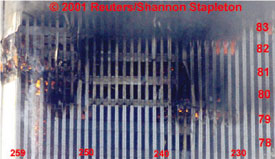 |
|
EXTRA LOADS Debris is on northeast corner of Two WTC at floors 80, 81 and on 79 at right. (Image courtesy of NIST) |
The June 18 announcement in New York City, made by Shyam Sunder of the National Institute of Standards and Technology, Gaithersburg, Md., implies that floor trusses, under close scrutiny since 9/11, did not fail first.
This seems to confirm the findings of the team of consultants working for Silverstein Properties, the WTC leaseholder, says Richard L. Tomasetti, co-chairman of Thornton-Tomasetti Group, New York City, and a member of Silversteins team (ENR 11/04/02 p. 12).
In December, a draft of the final NIST report will be issued for public comment. The final report, with recommendations, will be issued next spring, said Sunder, who presented the 1,054-page progress report. The two-year study, authorized by the National Construction Safety Team Act (NCSTA) of October 2002, is late. The delay is mostly due to the complexity and scope of the investigation, said Sunder. He stressed it is a fact-finding, not a fault-finding, exercise intended to result in recommen-dations to help make buildings perform better in extreme events.
|
The report also offers updates on NISTs separate WTC research and development program, so far costing $3 million in fiscal 2003 and $5 million in fiscal 2004. The Safety of Threatened Buildings Program is designed to help implement recommendations of the WTC study and provide the technical basis for cost-effective improvements to building and fire codes, standards and practices.
From the research, NIST reports it will publish in several months a best-practices guide for mitigating progressive collapse of buildings. Next, NIST will create a national R&D road map for fire safety design and retrofit of structures. The research also will develop a methodology for determining the performance of partitions in fires and guidelines and simulation tools for mitigation of chemical, biological and radiological aerosol attacks.  Click here to view image
Click here to view image
NISTs progress report, available at wtc.nist. gov, also includes a working hypothesis for the collapse of Seven WTC, before burnout but after seven hours of burning unattended. The 47-story steel-framed building was hit by structure and debris...
he lead investigator of the $16-million Federal Building and Fire Safety Investigation of the World Trade Centers destruction says the teams working hypothesis is that columns, weakened by fires ignited by jet fuel, failed and triggered the collapse of the twin 110-story towers.
Post a comment to this article
Report Abusive Comment